Every machinist hates breaking taps. It’s a real pain to extract a broken tap without damaging the part. Plus, tapping always seems to be one of the last operations done on a part, which helps ensure the highest cost if you need to scrap the part. But seven things greatly will reduce the number of broken taps you have to deal with.
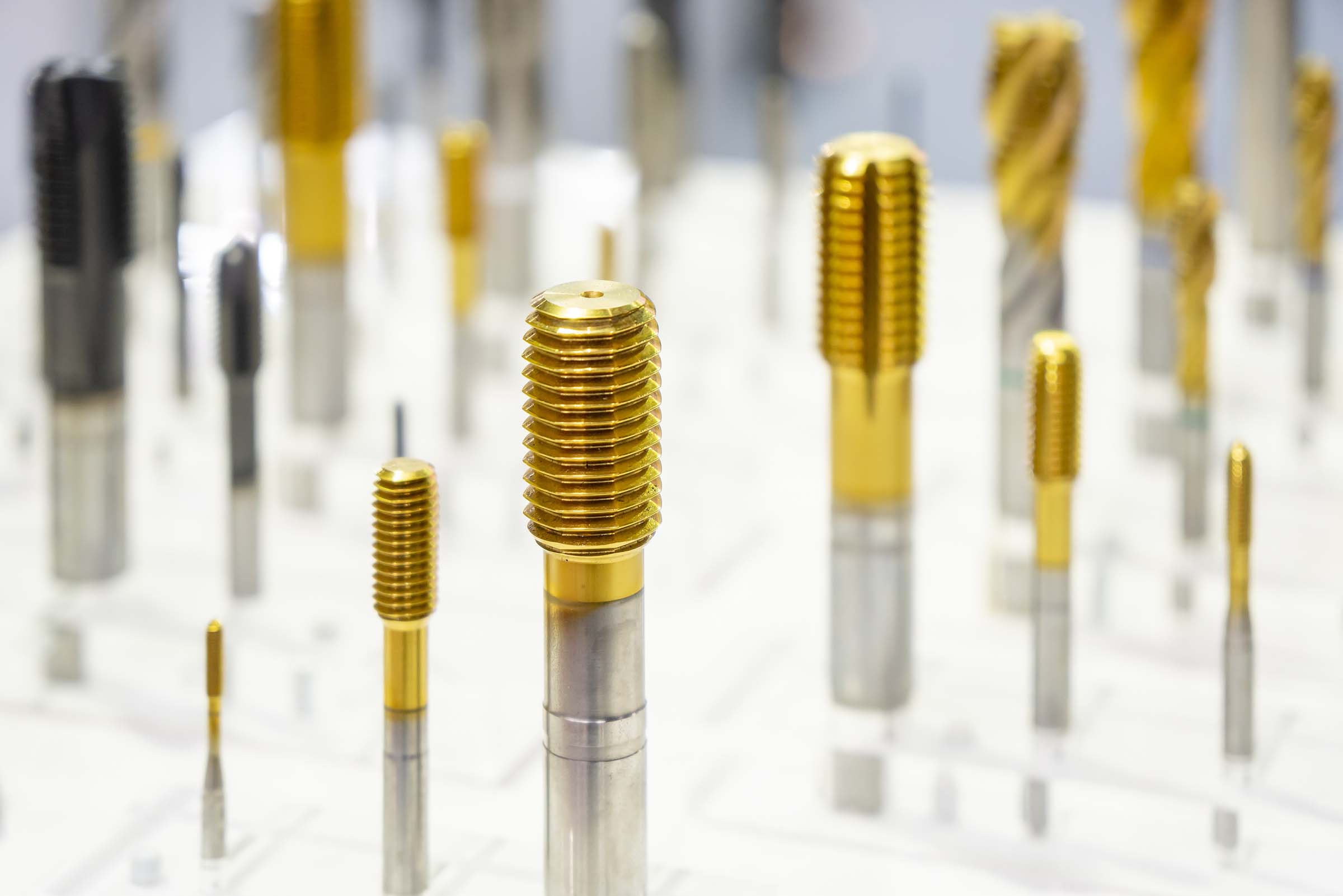
1. Choose the best hole size.
This is the tip that should make the biggest difference. Look, the recommended hole size found on the packaging for the tap or in your drill index probably is not the best size. It’s important to realize that there is no single drill size for a tap. Different drill sizes result in different thread percentages.
Here’s what is key: A 100% thread is only 5% stronger than a 75% thread but requires three times the torque. So for just a tiny bit stronger thread, you wind up with a much greater chance of breaking a tap.
The recommended drill size is almost always a 75% thread. That provides great strength but is well into the zone of too much torque.
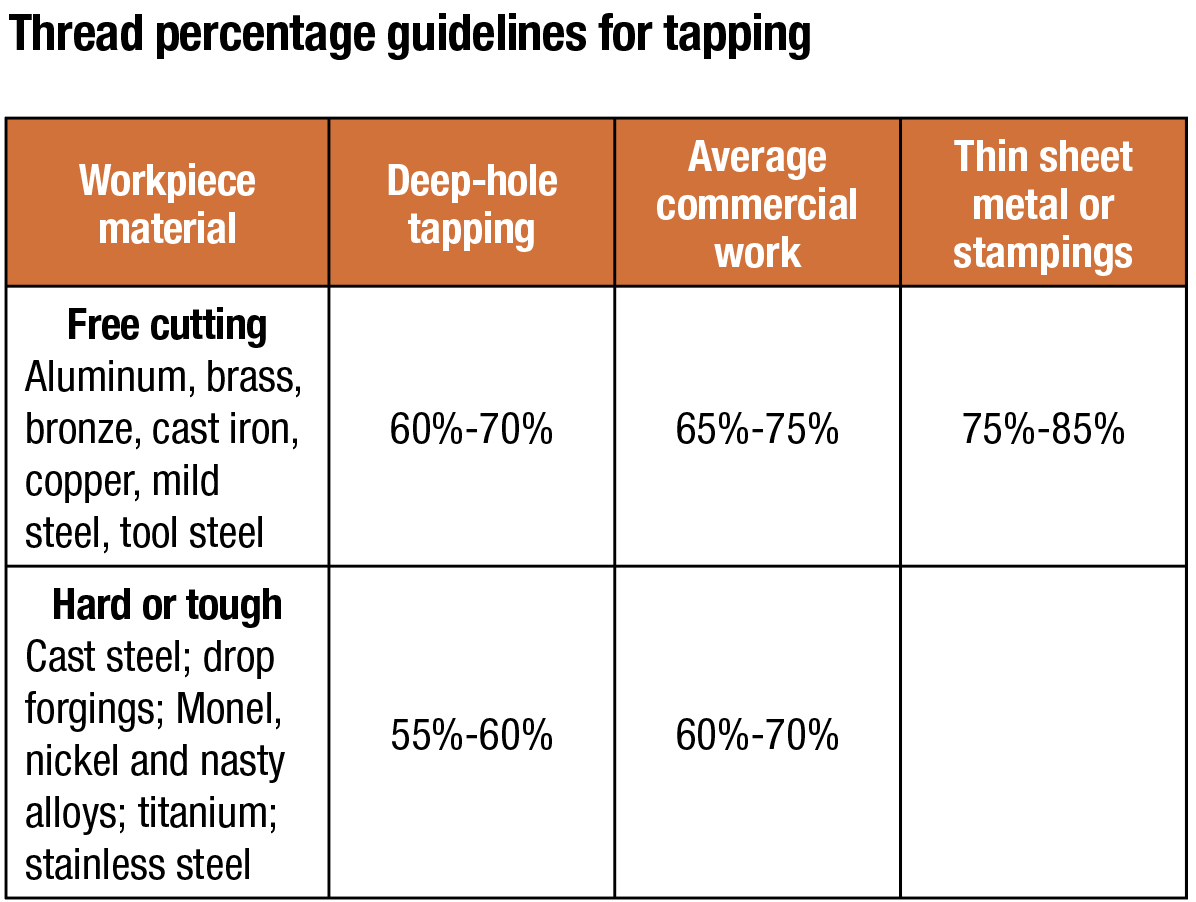
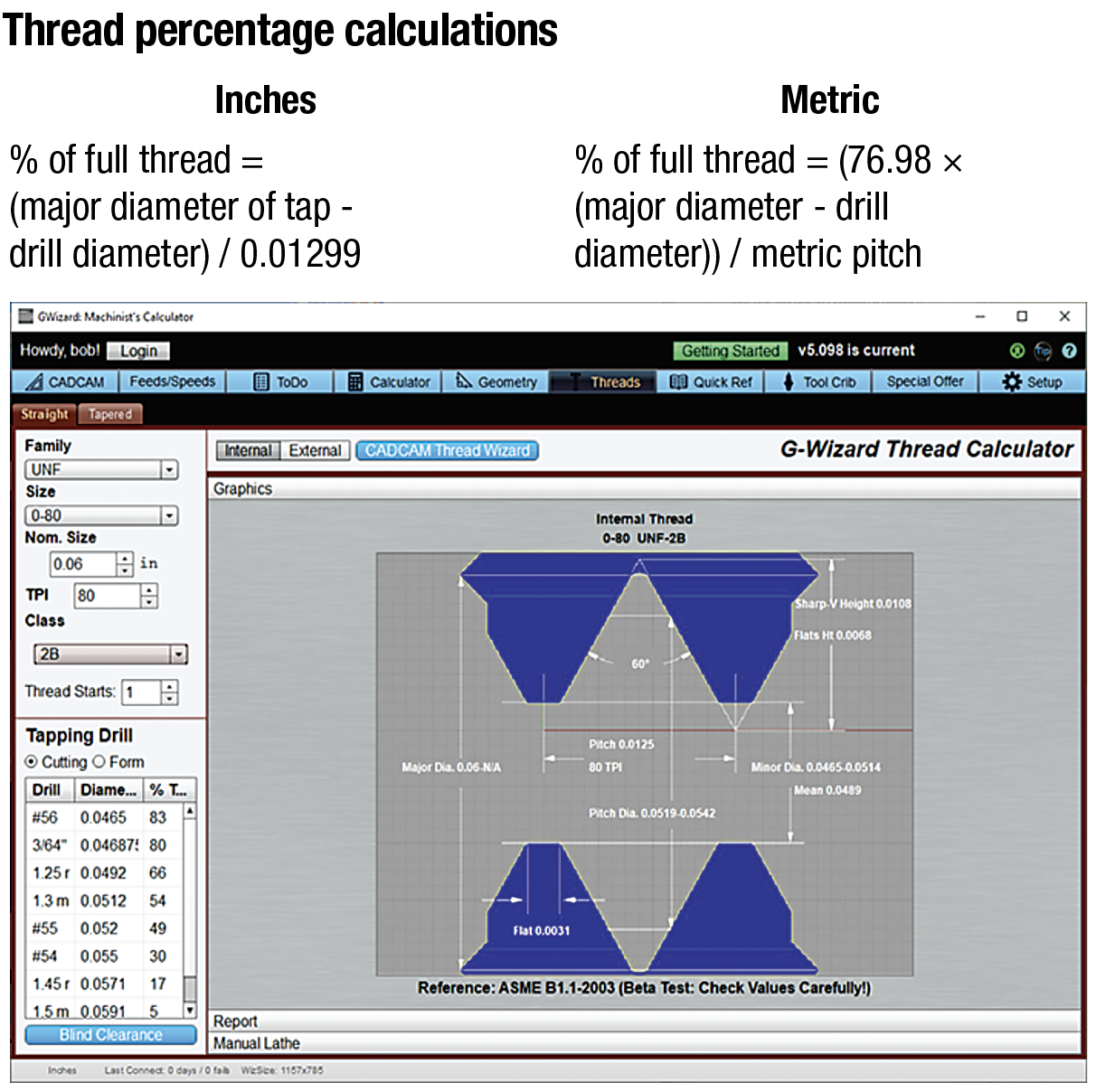
The table about thread percentage guidelines for tapping gives advice based on different conditions. Dial back to less than 75% when tapping deep holes. Dial back for hard, tough materials too.
Make sure to check the requirements of the job. A customer may need a particular thread percentage. But if not or if the work is within the ranges in this table, back off the thread percentage, and your taps will thank you.
Calculating thread percentage is easy. The formulas are found in the figure about thread percentage calculations. Or you can use a handy tool like the G-Wizard machinist’s calculator, which is pictured in the figure.
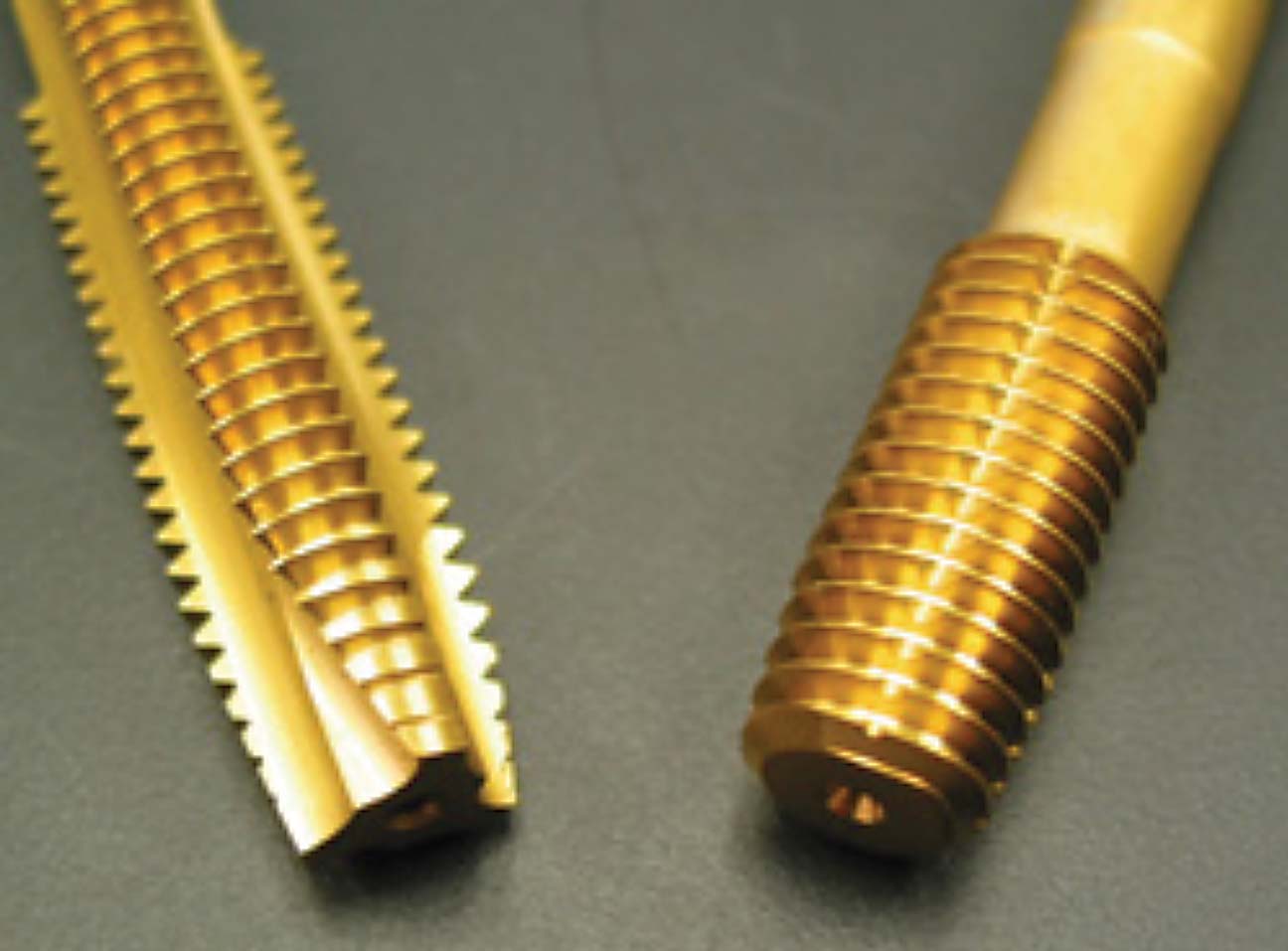
2. Use form taps whenever possible.
They don’t generate chips, and they push material into shape, cold forming the threads. The most common reason why taps break is because they become bound up in their own chips, which can’t happen with a form tap. Form taps also have a greater cross section, so the taps themselves are stronger than cutting taps.
Form taps have two disadvantages. First, form taps can’t be used on hard materials. You can form-tap materials up to only 36 HRC. That’s a lot more materials than you might think, but there are definitely materials that can’t be form-tapped. Second, some industries don’t allow form taps because the process may create voids that trap contaminants on the threads. Form tapping also can result in stress risers on threads.
3. Always consider thread milling instead of tapping for critical or tough jobs.
Thread mills last longer than taps on a job, though thread mills do cut more slowly. You can thread closer to the bottom of a blind hole, and a single thread mill can cut a variety of thread sizes. Plus, thread mills can be used with harder materials than taps use. Thread mills may be the only option for materials over 50 HRC. Lastly, if you break a thread mill, it’s smaller than the hole, so it won’t become stuck in the part the way that a tap might.
4. Consider a purpose-made tapping lubricant.
Most machine coolants, especially water-soluble ones, are not as good for tapping. If you’re having problems, try using special tapping lubricant. Put it in a spill-proof cup that sits on the machine table, and program the G code to automatically dip the tap in the cup. You also may try coated taps, which add lubricity through their coatings.
5. Use the right toolholder.
Let’s talk about toolholders for tapping. To start, use a holder that locks the square shank on a tap so it can’t twist in the holder. Tapping uses a lot of torque, so having a positive lock on that shank is helpful. You can do that with chucks made for taps or with special ER tapping collets.
Second, consider a floating holder even if your machine supports rigid tapping. Floating holders are a must without rigid tapping, but they increase tap life even in most rigid tapping situations. That is because machines are limited by the acceleration of spindles and axes on how closely machines can synchronize taps to the threads being made. There’s always some axial force pushing or pulling. A floating holder relieves stress from the lack of perfect synchronization.
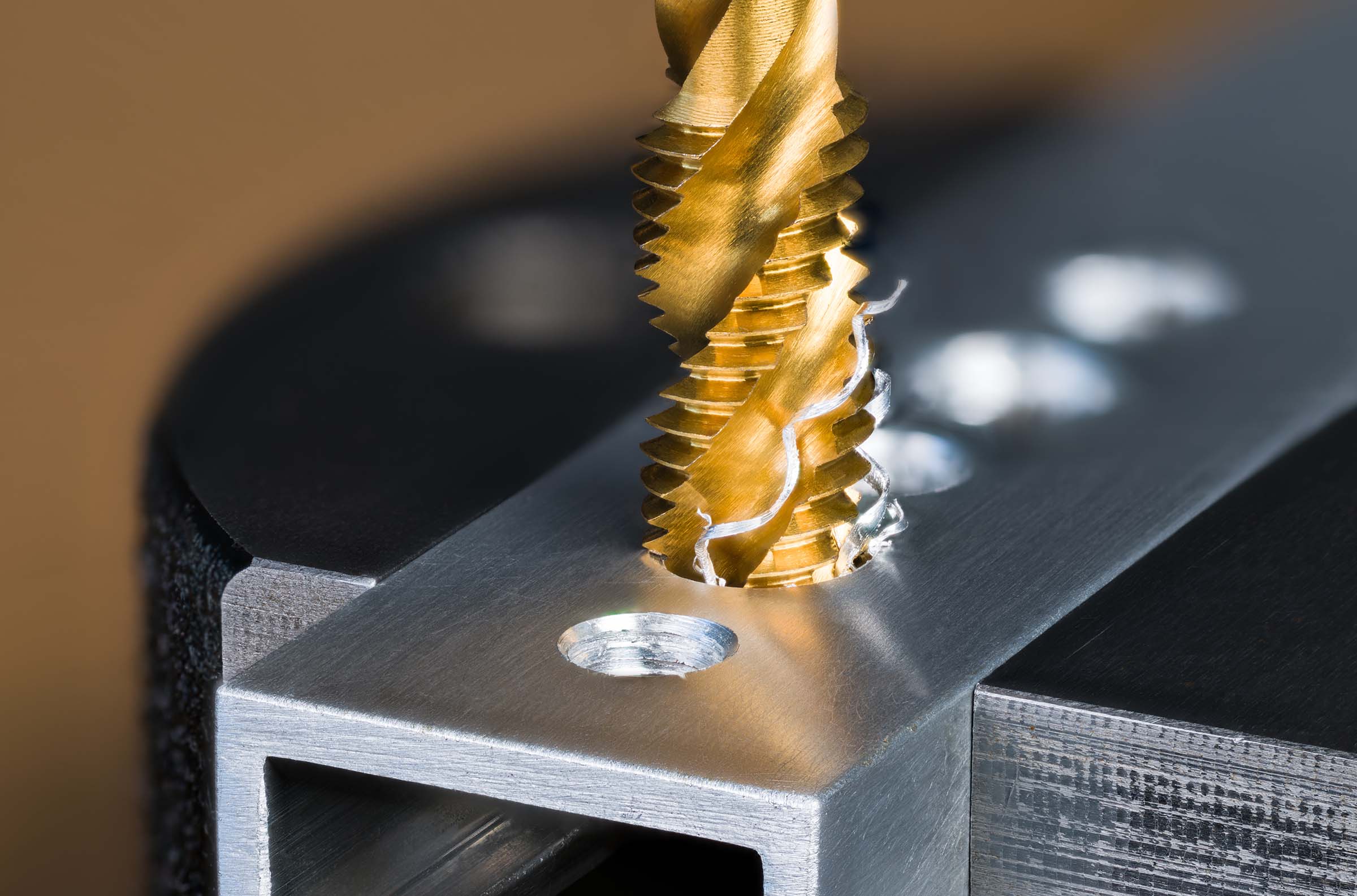
6. Use spiral-fluted taps when appropriate.
If you’re tapping a blind hole, failure to extract chips is the most common reason that taps are broken. That’s why we use spiral-fluted taps. They eject chips up and out of a hole. Note that spiral-fluted taps are not as strong as the more common spiral-point taps, which is why spiral-fluted taps are not used all the time. Use them just for blind holes.
7. Mind the depth.
Speaking of blind holes, my seventh and last tip is to mind the depth on them. Crashing a tap into the bottom of a blind hole almost certainly will break the tap.Many people are not aware of this, but you can calculate how much clearance to leave at the bottom, and it’s probably more than you’d think.Taken together, these seven tips should dramatically reduce the risk of breaking taps at a shop.
View a video presentation of this article at cteplus.delivr.com/2vb86
Related Glossary Terms
- axial force
axial force
When drilling, a force that is directed axially—along the direction of machining. The magnitude of an axial force rises with the drill’s diameter and the chisel edge’s width. Axial force is also known as thrust. When turning and boring, the term “feed force” is commonly used instead of “axial force.” See cutting force.
- clearance
clearance
Space provided behind a tool’s land or relief to prevent rubbing and subsequent premature deterioration of the tool. See land; relief.
- gang cutting ( milling)
gang cutting ( milling)
Machining with several cutters mounted on a single arbor, generally for simultaneous cutting.
- lubricity
lubricity
Measure of the relative efficiency with which a cutting fluid or lubricant reduces friction between surfaces.
- milling
milling
Machining operation in which metal or other material is removed by applying power to a rotating cutter. In vertical milling, the cutting tool is mounted vertically on the spindle. In horizontal milling, the cutting tool is mounted horizontally, either directly on the spindle or on an arbor. Horizontal milling is further broken down into conventional milling, where the cutter rotates opposite the direction of feed, or “up” into the workpiece; and climb milling, where the cutter rotates in the direction of feed, or “down” into the workpiece. Milling operations include plane or surface milling, endmilling, facemilling, angle milling, form milling and profiling.
- milling machine ( mill)
milling machine ( mill)
Runs endmills and arbor-mounted milling cutters. Features include a head with a spindle that drives the cutters; a column, knee and table that provide motion in the three Cartesian axes; and a base that supports the components and houses the cutting-fluid pump and reservoir. The work is mounted on the table and fed into the rotating cutter or endmill to accomplish the milling steps; vertical milling machines also feed endmills into the work by means of a spindle-mounted quill. Models range from small manual machines to big bed-type and duplex mills. All take one of three basic forms: vertical, horizontal or convertible horizontal/vertical. Vertical machines may be knee-type (the table is mounted on a knee that can be elevated) or bed-type (the table is securely supported and only moves horizontally). In general, horizontal machines are bigger and more powerful, while vertical machines are lighter but more versatile and easier to set up and operate.
- shank
shank
Main body of a tool; the portion of a drill or similar end-held tool that fits into a collet, chuck or similar mounting device.
- tap
tap
Cylindrical tool that cuts internal threads and has flutes to remove chips and carry tapping fluid to the point of cut. Normally used on a drill press or tapping machine but also may be operated manually. See tapping.
- tapping
tapping
Machining operation in which a tap, with teeth on its periphery, cuts internal threads in a predrilled hole having a smaller diameter than the tap diameter. Threads are formed by a combined rotary and axial-relative motion between tap and workpiece. See tap.
- toolholder
toolholder
Secures a cutting tool during a machining operation. Basic types include block, cartridge, chuck, collet, fixed, modular, quick-change and rotating.


